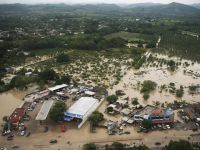Around 200 anti-nuclear protestors greeted a vessel after it docked Tuesday carrying an unprecedented shipment of spent atomic fuel intended for reprocessing in northern Japan.
"The ship has docked at Rokkasho bay and is being unloaded," said Kyoji Ebisawa, a spokesman for the reprocessing plant's operator Japan Nuclear Fuel Ltd.
At least 200 protestors chanted as cranes lifted four containers of fuel off the ship onto trucks for the seven-kilometer (4.4-mile) journey to a new reprocessing facility, which is due to be completed by 2005.
"Don't turn Rokkasho into a nuclear dump," demonstrators shouted.
The 4,913-ton Rokueimaru carrying 24 tons of spent nuclear fuel arrived at the village port of Rokkasho, on the northern tip of Japan's main Honshu island, after a 400-kilometer (250-mile) voyage from Fukushima to the south.
It was the first shipment after the government of Aomori prefecture, 600 kilometers (375 miles) north of Tokyo, agreed in October to host the new reprocessing facility.
Japan's only existing spent nuclear fuel reprocessing plant at Tokaimura, 120 kilometers (70 miles) northeast of Tokyo, reopened late last month after a 1997 explosion which exposed 37 workers to radiation.
Two workers were killed in a accident at a nearby uranium plant in Tokaimura in September last year. The first fatal nuclear accident since Chernobyl in 1986 renewed public fears about Japan's nuclear industry.
With the reprocessing in Tokaimura still limited to a small amount, Japan's 51 nuclear reactors have run out of storage space for used fuel rods and spent fuel has been sent to Britain and France.
Spent fuel will be stored at the new facility until it is finished, with Japan Nuclear Fuel aiming to collect 1,600 tons by 2005.
"With the first shipment, we hope to make solid strides towards the full-scale operation of our reprocessing business," the company spokesman said.
Japan Nuclear Fuel and Tokyo Electric Power Co., which runs the Fukushima power plant sending fuel to the new site, insist the transport and storage of the fuel is safe.
But environmentalists reacted with dismay.
"By calling it a reprocessing plant, the government wants to turn the village into a nuclear dump site," said Kazue Suzuki, a spokeswoman at Greenpeace Japan.
"The only solution to the waste problem is to scrap the nuclear plants," she told AFP.
Greenpeace complains that the government has failed to fully explain what will happen to the reprocessed fuel.
The plant will be able to handle 800 tons of spent fuel a year and recover 4.8 tons of plutonium, which can be used for nuclear weapons.
As of September, 8,910 tons of spent nuclear fuel lay in temporary storage at plants across Japan.
"It is incredibly rash that they push overflowing, dangerous nuclear waste into a facility that is still under construction," the National Christian Council of Japan protested in a statement.
But the village of Rokkasho pointed to improved living standards brought about by the construction of the reprocessing plant.
"Although we used to subsist mainly on fishing and agriculture, more people are now engaged in other jobs, such as construction and services," said village official Yasuhiro Koizumi.
There is growing public mistrust of nuclear power nationwide, however. After the deadly Tokaimura accident, the government in March abandoned plans to build 16-20 new nuclear power plants by 2011 - TOKYO (AFP)
© 2000 Al Bawaba (www.albawaba.com)







